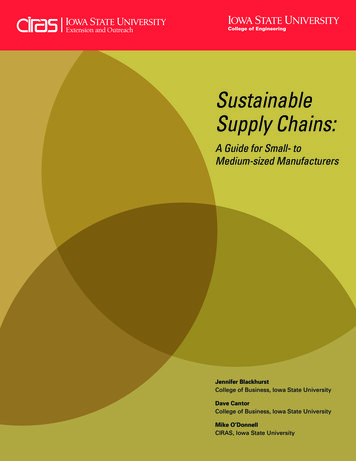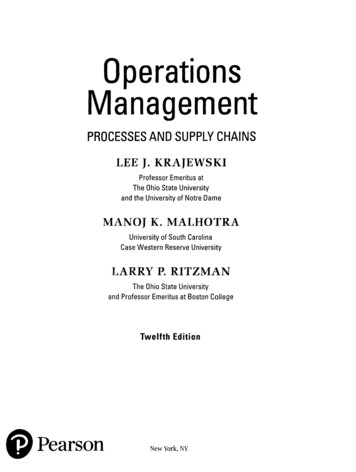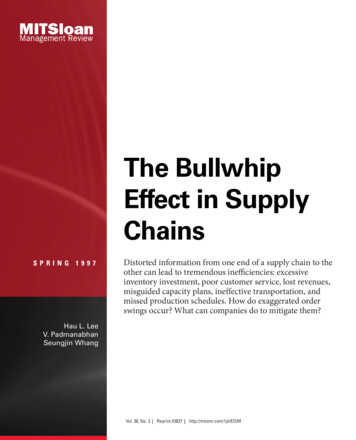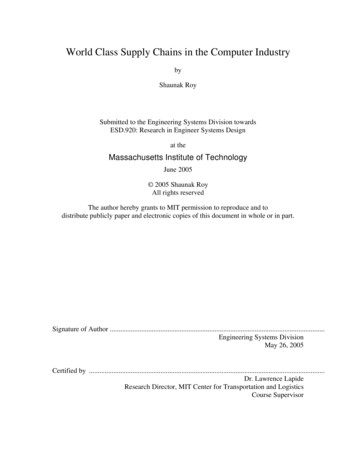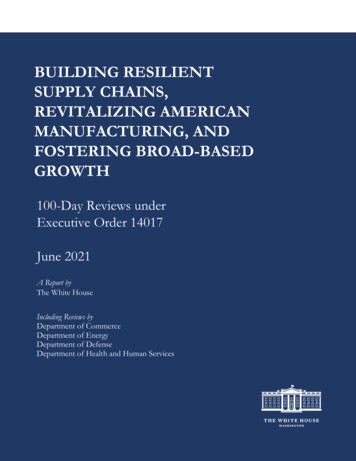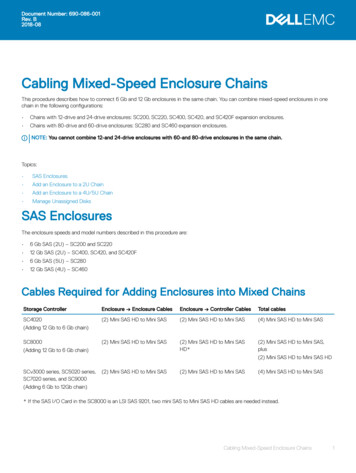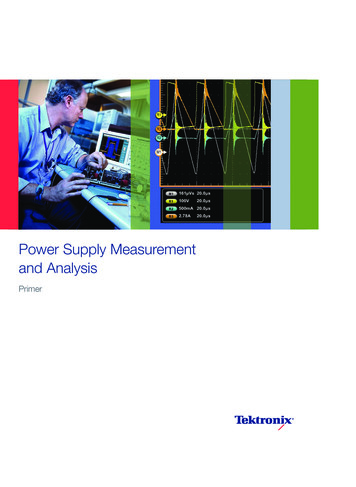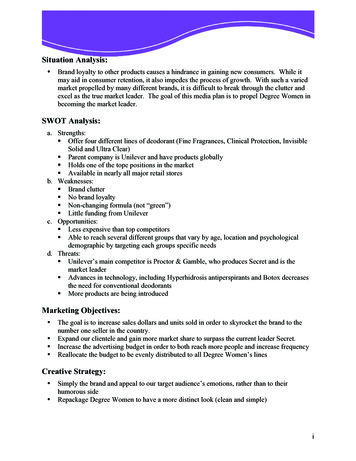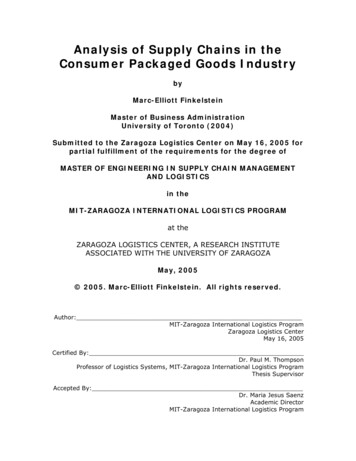
Transcription
Analysis of Supply Chains in theConsumer Packaged Goods IndustrybyMarc-Elliott FinkelsteinMaster of Business AdministrationUniversity of Toronto (2004)Submitted to the Zaragoza Logistics Center on May 16, 2005 forpartial fulfillment of the requirements for the degree ofMASTER OF ENGINEERING IN SUPPLY CHAIN MANAGEMENTAND LOGISTICSin theMIT-ZARAGOZA INTERNATIONAL LOGISTICS PROGRAMat theZARAGOZA LOGISTICS CENTER, A RESEARCH INSTITUTEASSOCIATED WITH THE UNIVERSITY OF ZARAGOZAMay, 2005 2005. Marc-Elliott Finkelstein. All rights reserved.Author:MIT-Zaragoza International Logistics ProgramZaragoza Logistics CenterMay 16, 2005Certified By:Dr. Paul M. ThompsonProfessor of Logistics Systems, MIT-Zaragoza International Logistics ProgramThesis SupervisorAccepted By:Dr. Maria Jesus SaenzAcademic DirectorMIT-Zaragoza International Logistics Program
Analysis of Supply Chains in theConsumer Packaged Goods IndustryByMarc-Elliott FinkelsteinMaster of Business AdministrationUniversity of Toronto (2004)Submitted to the Zaragoza Logistics Center on May 16, 2005 forpartial fulfillment of the requirements for the degree ofMASTER OF ENGINEERING IN SUPPLY CHAIN MANAGEMENTAND LOGISTICSin theMIT-ZARAGOZA INTERNATIONAL LOGISTICS PROGRAMat theZARAGOZA LOGISTICS CENTER, A RESEARCH INSTITUTEASSOCIATED WITH THE UNIVERSITY OF ZARAGOZAKeywords:2020, InBev, beverage, Interbrew, AmBev, supply chain2
AbstractA contribution to the MIT Supply Chain 2020 research project, this paperattempts to delineate factors in the supply chain of InBev which are “excellent”.Using the framework provided by Michael E. Porter in his article What Is Strategy?,InBev will be analyzed based on the effectiveness of its underlying operatingactivities and how they, cohesively, support its competitive strengths.InBev operates in the consumer packaged goods industry, in a segment calledbeverages. Manufacturing beer, soft drinks, isotonic beverages, and several others,InBev competes in nearly all categories, against such prominent firms as: CocaCola, Diageo, Anheuser-Busch, Pepsi, and several others.InBev has a presence in 140 countries, producing over 200 brands, and holdsa 14% global market share. Broken into five autonomous business units, InBev’soperations are almost entirely disconnected, except for the movement of globalbrands.InBev outsources several of their functions in several regions, includinginformation technology, transportation, and other “non-core functions”. InBevclaims that brewing is their core competency, despite outsourcing the brewing oftheir flagship brands in several countries. Through licensing and reciprocalagreements, most beverage firms are outsourcing some of their production as ameans to gain entry into desired markets.In reconciling the research findings to the Porter framework, it is found thatthe operations in Belgium do not comprise an “excellent” supply chain, and3
consequently lack an activity system which is supportive of business practices. Infact, InBev Belgium is found to have no competitive advantage at all, only distinctionin their brewing methods. Some degree of “consistency” is apparent, but the chainlacks solid first- and second-order fit.Comparing InBev’s Belgian operations to their Brazilian operations (AmBev),yields significant differences. AmBev possess a strong competitive advantage, whichhas resulted in tremendous market dominance in most of South America. AmBev’ssupport activities are intricate and numerous, and all work to reinforce andstrengthen their competitive position.Finally, this paper examines the future of the beverage industry, remarkingon the present trend towards homogeneity. Prognostication takes into accountcurrent trends, describing potential outcomes under several conditions.4
AcknowledgementsI would like to thank all parties who contributed directly or indirectly to thecompletion of this thesis. My thesis advisor, Dr. Paul M. Thompson, who helped immensely inproviding insight, imparting wisdom and helping smooth the rough spots. Dr. Larry Lapide, leader of the Supply Chain 2020 project, kept meinspired and eager to be involved in this project. He added clarity,frankness and understanding to this experience, and he always went outof his way to assist his researchers. The supportive and skilled staff at InBev, all of whom were highlycooperative and professional. Notable contributions came from KoenGoossens, Paul Timmermans, Sofie Aernouts, and Marie-JeanneLambrechts. The other Supply Chain 2020 researchers, who patiently listened to allpresentations, and offered new insight through their intelligent andthought-provoking questions. The helpful and articulate individuals at SAP who provided assistance inpainting a picture of the CPG industry: Emiel Van Schaik, Stefan Boernerand Wolfgang Peter. And lastly and most importantly, my beautiful wife Simone Finkelstein,who had the patience and devotion to endure my hectic schedule andboring supply chain stories, all the while keeping my side of the bedwarm, despite being across the Atlantic.5
6
Table of ContentsAbstractAcknowledgementsTable of ContentsOperating DefinitionsChapter 1: IntroductionChapter 2: Literature ReviewChapter 3: Industry Overview3.1 Industry Trends3.2 Five Forces Analysis3.2.1 Rivalry Among Existing Competitors3.2.2 Threat of New Entrants3.2.3 Bargaining Power of Suppliers3.2.4 Threat of Substitute Products or Services3.2.5 Bargaining Power of Consumers3.3 Industry Drivers3.4 Industry Evolution3.5 Top Four Companies3.6 Coca-Cola3.6.1 History3.6.2 Operations3.6.3 Geographic Performance3.6.4 Challenges & Opportunities3.6.5 Summary3.7 Nestlé3.7.1 Overview3.7.2 Logistics3.7.3 Challenges3.7.4 Summary3.8 Anheuser-Busch3.8.1 Overview3.8.2 History3.8.3 Marketing3.8.4 Challenges & Opportunities3.8.5 Summary3.9 Diageo PLC3.9.1 Strategy3.9.2 History3.9.3 Sales3.9.4 Logistics3.9.5 Challenges and Opportunities3.9.6 SummaryChapter 4: InBev Position in the Industry4.1 History4.2 Brands4.3 Strategy4.4 Operations4.5 Supply Chain4.6 Challenges & OpportunitiesChapter 5: InBev’s Specific Supply 7
5.1 Brands5.2 Plants5.3 Channels5.4 Customer Segments5.5 Competitive Positioning5.6 Products5.7 Sourcing5.8 Performance5.9 Transportation5.10 Quality ControlChapter 6: Supply Chain Analysis6.1 AnalysisChapter 7: AmBev Specific Supply Chain7.1 History7.2 Performance7.3 Risk Factors7.4 Market Conditions7.5 Brazilian Beer Market7.5.1 Low Per Capita Beer Consumption7.5.2 Channels7.5.3 Prevalence of Returnable Packaging7.5.4 Pricing7.5.5 Seasonality in Sales7.6 Brazilian Soft Drink Market7.6.1 Soft Drinks Consumption7.6.2 Flavours7.6.3 Packaging7.6.4 Channels7.6.5 Pricing7.6.6 Seasonality7.7 Brazilian Non-Alcoholic and Non-Carbonated Beverages Market7.7.1 NANC Consumption7.7.2 Seasonality7.8 Business Strategy7.9 Products and Brands7.10 Beer Sales in Brazil7.11 Carbonated Soft Drinks Sales in Brazil7.12 International Operations7.13 Distribution and Sales7.13.1 Distribution7.13.1.1 Third-Party Distribution Network7.13.1.2 Direct Distribution System7.13.2 Sales7.13.2.1 Points of Sale7.13.2.2 Terms of Sale7.13.2.3 Sales Force7.13.2.4 Pricing7.13.2.5 Marketing7.13.2.6 Packaging7.14 Competition in Beer7.15 Competition in Soft Drinks7.16 Procurement7.16.1 Beer 281291308
7.16.2 Soft Drink Ingredients7.16.3 Packaging7.17 Property, Plant and Equipment7.18 Logistics7.19 Innovation and Knowledge Management7.20 Environmental Matters7.21 Employees7.22 Training7.23 Industrial Relations7.24 Profit-Sharing Plan7.25 Commodity Risk7.25.1 Foreign Exchange Risk7.26 Financial Performance 2001-2003Chapter 8: AmBev Supply Chain Analysis8.1 Analysis8.1.1 ComplementarityChapter 9: Comparison and Contrast - AmBev Versus Interbrew BelgiumChapter 10: Predictions for the Beverage Industry for 202010.1 Trends10.2 Innovation10.3 Summary PredictionsSources ConsultedAppendix 1 – Diageo’s Geographic PresenceAppendix 2 – The Diageo Way of Brand Building (DWBB)Appendix 3 – Porter’s Five Forces Industry Analysis: Beverages IndustryAppendix 4 – Map of AmBev’s South American OperationsAppendix 5 – Beer Brewing ProcessAppendix 6 – Ale Family of BeersAppendix 7 – Lager Family of BeersAppendix 8 – Definitions of “Fit”, “Consistency” and “Complementarity”Appendix 9 – AmBev Activity System 81511551551571571591631641651661671681691701739
Operating DefinitionsCompetitive Advantage – “Competitive advantage is a function of either providingcomparable buyer value to competitors but performing activities efficiently (lowcost), or of performing activities at comparable cost but in unique ways that creategreater buyer value than competitors and, hence, command a premium price(differentiation).” (Porter, 1986)Competitive Strategy - “Competitive strategy is about being different. It meansdeliberately choosing a different set of [business] activities to deliver a unique mix ofvalue.” (Porter, 1996)Core Competency – “Core competencies are the collective learning in theorganization [they] are enhanced as they are applied and shared. Butcompetencies still need to be nurtured and protected; knowledge fades if it is notused. Competencies are the glue that binds existing business.” “Three tests can beapplied to identify core competencies in a company. First, a core competencyprovides potential access to a wide variety of markets.” “Second, a core competenceshould make a significant contribution to the perceived customer benefits of the endproduct.” “Finally [and most importantly], a core competence should be difficult forcompetitors to imitate.” (Prahalad and Hamel, 1990).Core Adjacency – “[Core] Adjacency expansion is a company's continual moves intorelated segments or businesses that utilize and, usually, reinforce the strength of theprofitable core.” “What makes adjacency expansion different from other growthstrategies is its use of existing customer relationships, technologies or core businessskills to build competitive advantage in a new area. Companies pursuing new growthinitiatives without jeopardizing a strong core can benefit from methodicallyinventorying and mapping out their adjacent opportunities.” (Zook, 2004)Corporate Strategy – “Corporate strategy is what makes the corporate whole add upto more than the sum of its parts.” (Porter, 1987).Fit – See Appendix 8Operational Effectiveness – “Operational effectiveness means performing similaractivities better than rivals perform them.” (Porter, 1996)Strategy - “The essence of strategy is in the activities – choosing to performactivities differently or to perform different activities than rivals. Otherwise, astrategy is nothing more than a marketing slogan that will not withstand thecompetition.” (Porter, 1996).10
Chapter 1: IntroductionThis thesis examines the beverages industry, specifically focusing on thesupply chain practices employed by InBev (formerly InterbrewAmBev), thebyproduct of the recent merger of Belgium’s Interbrew with Brazil’s Companhia deBebidas das Américas, also known as AmBev.“The Supply Chain 2020 Project intends to identify and analyze the factorsthat are critical to the success of future supply chains out to the year 2020. Phase 1largely entails researching today’s excellent supply chains to identify what isimportant to maintaining a competitive positioning, including the business strategies,operating models, goals, and best supply chain processes. In addition, the enablersof the best business practices will also be researched, as well as the cost-benefitrationale for these micro-based practices in the context of historical macro-basedfactors.” (Lapide, 2004)The framework used for this analysis is adapted from materials created forSupply 2020 researchers, which include original works from several authors.Attempts have been made to give credit to all contributors, but several have omittedtheir names, or other pertinent details from these works.11
Chapter 2: Literature ReviewSources used in obtaining data for this case study include a wide variety ofprint media, Internet research, phone conversations with experts, books, and severalothers.From existing business literature, much information was obtained from theworks of pre-eminent authors Michael Porter, Chris Zook, C.K. Prahalad, MichaelHammer, and several others.Most financial details were found in the annual reports of the respectivecompanies, all available via corporate websites.Interviews were conducted with senior InBev staff, and well as with severalindividuals at SAP who were industry experts in the consumer packaged goods (CPG)industry.Lastly, numerous articles were found through MIT’s online libraries. Throughsuch sources as Euromonitor, Proquest and others, huge repositories of opinion, factand figures were available.12
Chapter 3: Industry OverviewThe beverage industry consists of companies involved in the manufacture,bottling, wholesaling, warehousing, distribution or retailing of beverages. Theindustry of beverages is stratified into alcoholic and non-alcoholic beverages.Alcoholic beverage categories are wine, spirits, flavoured alcoholic beverages (FABs),beer, cider, and other (champagne, “malternatives”, etc). Non-alcoholic beveragesare often segmented as hot drinks or soft drinks. Hot drinks consists of coffee, tea,and other (hot chocolate, blended products, etc). Soft drinks consist of carbonates,fruit/vegetable juice, bottled water, functional drinks (sports/isotonic, energy, etc.),RTD (ready to drink) coffee, RTD tea, and RTD concentrates (“This comprises liquidand powder concentrates in ready to drink measure. RTD concentrates volumes arecalculated by applying an average conversion ratio for each country to ‘as sold’ liquidand powder volumes.”) (Euromonitor
Analysis of Supply Chains in the Consumer Packaged Goods Industry by Marc-Elliott Finkelstein Master of Business Administration University of Toronto (2004) Submitted to the Zaragoza Logistics Center on May 16, 2005 for partial fulfillment of the requirements for the degree of MASTER OF ENGINEERING IN SUPPLY CHAIN MANAGEMENT AND LOGISTICS in the MIT-ZARAGOZA INTERNATIONAL
